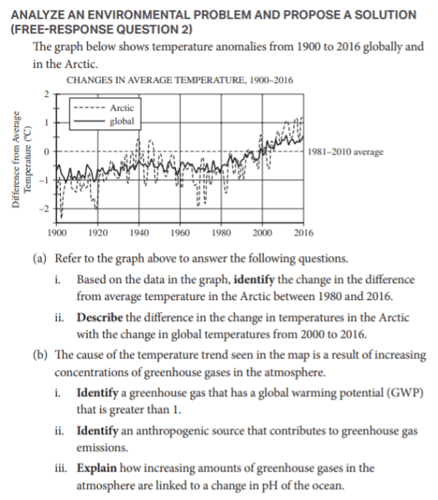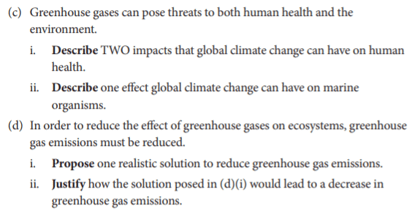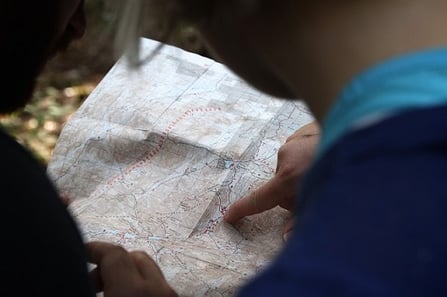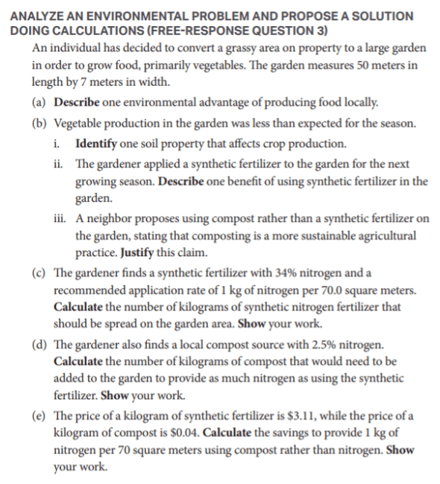
AP Environmental Science is one of the most popular AP classes, but it also has one of the lowest average scores among test takers. In fact, more than half the students who take the APES exam don't pass it. Oftentimes, the hardest part of this test is the free-response section, which students struggle with because they aren't sure what to expect or what information graders are looking for.
Fortunately, this guide can help! We'll go over each type of AP Environmental Science FRQ, give sample problems and explanations, and offer tips to help you get your best score.
Format of the AP Environmental Science FRQ Section
The AP Environmental Science exam consists of two sections. First, you'll have 90 minutes to answer 80 multiple-choice questions; you'll then move on to the free-response section, which lasts 70 minutes and consists of three questions. (Note that the exam structure was updated in 2020: prior to these changes, you used to have to answer four free-response questions in 90 minutes.)
You'll also now be able to use a graphing calculator at any point on the exam. For more details on the new format, check out our in-depth guide to the AP Enviro class and exam.
The three types of free-response questions on the AP exam will stay consistent from year to year. Here's what you can expect with each question, per the College Board:
- Question 1 will ask students to design and analyze an investigation
- Question 2 will ask students to analyze an environmental problem and propose a solution using models and representations
- Question 3 will ask students to analyze an environmental problem and propose a solution using calculations
The free-response section is worth a total of 40% of your score. All questions are worth 10 points, making them each worth approximately 13.3% of your final AP score.
In the free-response section, you're expected to show reasoning and analytical skills, as well as the ability to synthesize information from multiple sources into coherent, logical responses.
AP Environmental Science FRQ Examples
Here are two examples of the types of free-response questions you'll see on the AP Enviro exam. For each question, we'll go through the answers so you can see exactly how points are earned. All sample questions come from the 2020 AP Enviro Course and Exam Description.
Free-Response Question 2 Sample


This free-response question is all about analyzing an environmental problem and identifying a possible solution to it. Here's how the 10 points are doled out:
- 2 points for part (a)
- 3 points for part (b)
- 3 points for part (c)
- 2 points for part (d)
Now, let's look at how you could earn full credit for this FRQ, according to the scoring guidelines.
(A) Solutions—2 Points
For part i (1 point):
Increased 1.5 degrees C
For part ii (1 point):
The temperature is increasing/warming faster/at a greater rate in the Arctic.
(B) Possible Solutions—3 Points
For part i (1 point), accept one of the following:
- Chlorofluorocarbons (CFCs)/Hydrofluorocarbons (HFCs)
- Methane (CH4)
- Nitrous Oxide (N2O)
For part ii (1 point), accept one of the following:
- Burning of fossil fuels
- Deforestation/Land use changes
- Livestock fermentation (methane release) and waste management
- Use of CFCs in products such as refrigeration systems, air conditioners, and manufacturing
- Use of fertilizer
For part iii (1 point):
Increased global temperature leads to increased ocean acidification because more CO2 is
absorbed by ocean waters which decreases the pH of the ocean water.
Looking for help studying for your AP exam?
Our one-on-one online AP tutoring services can help you prepare for your AP exams. Get matched with a top tutor who got a high score on the exam you're studying for!
(C) Possible Solutions—3 Points
For part i (2 points), accept two of the following:
- Increase in spread of vector diseases as habitat moves from tropics to poles
- Increase in algal blooms and waterborne diseases from increased water temperature
- Increase in exposure to extreme heat and cold/increase risk of illness and death from exposure to increased extreme temperatures
- Increase in chronic conditions (cardiovascular disease, respiratory disease, etc.) from prolonged exposure to temperature extremes
- Decrease in air quality leading to increased respiratory and cardiovascular diseases (i.e. asthma)
- Decreased water quality leading to contact with contaminated drinking water/water used for recreation/water used for sanitation
- Decreased food security/disruption to available food/disruption to access to food
For part ii (1 point), accept one of the following:
- Ocean warming can lead to loss of habitat for marine species
- Ocean warming can alter metabolic rates (increase) for marine species
- Ocean warming can alter reproductive rates and sex ratios in certain species
- Ocean warming can cause coral bleaching/loss of algae within corals
- Ocean warming may cause organisms, such as fish, to migrate toward the poles where water is cooler
(D) Possible Solutions—2 Points
For part i (1 point), accept one of the following:
- Use more energy efficient vehicles/decrease driving distances
- Decrease electricity use to decrease reliance on fossil fuels
- Use less heat/less air conditioning to reduce amount of energy to heat/cool home
- Switch from fossil fuel generated electricity to electricity generated from renewable sources
- Harvest methane from landfills for energy generation
- Sequester carbon through planting vegetation/reinjection
- Decrease use of plastics/fertilizers/products that require fossil fuels for production
- Decrease purchasing of products with plastic packaging
- Reduce meat consumption/switch to a vegetarian or vegan diet
For part ii (1 point), accept one of the following:
| Solution Proposed in (d)(i) | Justification of How Solution Will Reduce Greenhouse Gas Emissions |
| Use more energy efficient vehicles/decrease driving distances | Using more energy efficient vehicles or decreasing driving distances will decrease the amount of fossil fuels burned, which will decrease the amount of greenhouse gases, such as carbon dioxide, released into the atmosphere. |
| Use less heat/less air conditioning to reduce amount of energy to heat/cool home | Decreasing the use of electric heat/air conditioning will decrease the amount of fossil fuels burned for electricity generation, which will decrease the amount of greenhouse gases, such as carbon dioxide, released into the atmosphere. |
| Decrease electricity use to decrease reliance on fossil fuels | Decreasing the use of electricity used will decrease the amount of fossil fuels burned for electricity generation, which will decrease the amount of greenhouse gases, such as carbon dioxide, released into the atmosphere. |
| Switch from fossil fuel generated electricity to electricity generated from renewable sources | Renewable sources, such as solar or wind power, do not release greenhouse gases. Switching energy source will decrease the amount of fossil fuels burned, which will decrease the amount of greenhouse gases, such as carbon dioxide, released into the atmosphere. |
| Harvest methane from landfills for energy generation | The methane gas released from landfills can be collected and used for energy generation, which reduces the amount of methane released into the atmosphere. |
| Sequester carbon through planting vegetation/reinjection |
|
| Decrease use of plastics/fertilizers/products that require fossil fuels for production |
|
| Decrease purchasing of products with plastic packaging | Plastics release several greenhouse gases as they degrade. Purchasing fewer plastics will decrease the amount of plastics in landfills and decrease the release of greenhouse gases into the atmosphere during degradation. |
| Reduce meat consumption/switch to a vegetarian or vegan diet | Raising livestock produces large amounts of greenhouse gas emissions, specifically methane (from gut fermentation). Decomposition of manure from these operations also releases large amounts of CO2 and/or methane so a reduction in meat consumption or switching to a vegetarian or vegan diet could significantly reduce the amount of greenhouse gasses emitted into the atmosphere. |

Make it easy for the graders to find your answers.
Free-Response Question 3 Sample

For this free-response question, you'll need to do some math (likely using your graphing calculator) to solve different parts and earn full credit. The 10 points are doled out as so:
- 1 point for part (a)
- 3 points for part (b)
- 2 points each for parts (c), (d), and (e)
Here's how you could earn all 10 points for this question, per the official scoring guidelines.
(A) Possible Solutions—1 Point
Accept one of the following:
- Reduced atmospheric CO2 emissions from fewer trucks transporting food
- Reduced fossil fuel consumption from fewer trucks transporting food
- Increased genetic diversity of crops/increased biodiversity
- Ability to improve soil quality and nutrients
- Increased food security
(B) Possible Solutions—3 Points
For part i (1 point), accept one of the following:
- Soil texture
- Organic matter content
- pH
- Water holding capacity
For part ii (1 point), accept one of the following:
- The nutrients in synthetic fertilizers are readily available and can be taken up by the plant in a short period of time (days, not weeks)
- Synthetic fertilizers are formulated to have a certain ratio of nutrients, so only the limited nutrient(s) can be added to the soil
- Synthetic fertilizers are inexpensive and easily available
For part iii (1 point), accept one of the following:
- Production of synthetic fertilizer production requires the burning of fossil fuels and composting does not
- Compost maintains soil porosity, which limits runoff and synthetic fertilizers do not
- Compost reduces the amount of waste generated by using food scraps, paper, and yard wastes to create the organic fertilizer
- Composting reduces the amount of atmospheric methane since there is less food waste decomposing in landfills
- Compost can be produced on site and does not require transportation (less CO2, less fossil fuel combustion)
(C) Solution—2 Points

(D) Solution—2 Points

(E) Solution—2 Points


4 Critical Tips for Solving AP Enviro Free-Response Questions
The AP Environmental Science FRQs often trip students up, which is why it's crucial that you know exactly what to expect on test day. Below are four essential tips to keep in mind while studying and taking the test to help you improve your chances of scoring well on this tricky section.
Tip 1: Figure Out How Long You Want to Spend on Each Question
You'll have 70 minutes to complete the free-response section, which gives you about 23 minutes per question; however, you don't need to spend that exact same amount of time on every FRQ. In fact, you can divide your time between the three FRQs any way you want.
Some students might spend longer on the third question due to the calculations involved, whereas others might find this to be the easiest one. You could very well end up spending 15 minutes on one question and close to 30 minutes on another.
The best way to learn which FRQs take you longer is to do several practice problems, which we'll discuss in the next section. Once you're comfortable with each type of free-response question, you can go into test day knowing about how long you'll want to spend on each type.
Additionally, note that you absolutely don't have to answer the questions in order. When you start the section, give them a quick look-through and decide which one you'd like to answer first. A lot of people choose to start with the question they're most confident in so that they'll (hopefully!) have some extra time at the end for the question(s) they find trickier.
Tip 2: Get Comfortable Using Your Calculator
Up until 2020, students weren't allowed to use a calculator on the AP Environmental Science exam; now, however, you'll have access to one for the duration of the test, including on the free-response section. As a result, it's very important that you get comfortable with using your calculator to help you solve problems and do calculations quickly and accurately.
This tip is especially relevant to Question 3 of the FRQs, since this one will require you to propose a solution using mathematical calculations. As you saw with the sample question, you'll usually get 1 point for showing your work and 1 point for finding the correct answer for each question part that involves calculations.
It's a good idea to check and double-check your solutions with your graphing calculator as well.
If you feel that you're struggling with finding the best way to use your calculator on the APES exam, practice with some official free-response questions (ideally, ones that mimic the rough structure of Question 3 on the new test format).
Tip 3: Familiarize Yourself With the Task Verbs
Every part of every AP Enviro free-response question contains a task verb, or a specific command that tells you what you must do to earn credit. Knowing what kinds of command verbs you can expect and what they mean will help you feel more prepared to answer the questions.
Here are the most common task verbs for the FRQs, according to the AP Enviro Exam Description:
- Calculate: Perform mathematical steps to arrive at a final answer, including algebraic expressions, properly substituted numbers, and correct labeling of units. Showing work is required.
- Describe: Provide the relevant characteristics of a specified topic.
- Explain: Provide information about how or why a relationship, process, pattern, position, situation, or outcome occurs, using evidence and/or reasoning to support or qualify a claim. Explain "how" typically requires analyzing the relationship, process, pattern, position, situation, or outcome; whereas, explain "why" typically requires analysis of motivations or reasons for the relationship, process, pattern, position, situation, or outcome. Also phrased as "give one reason."
- Identify: Indicate or provide information about a specified topic, without elaboration or explanation.
- Justify: Provide evidence to support, qualify, or defend a claim and/or provide reasoning to explain how that evidence supports or qualifies the claim.
- Make a claim: Make an assertion that is based on evidence or knowledge.
- Propose a solution: Provide a proposed solution to a problem based on evidence or knowledge.
Tip 4: Keep Your Units Straight
My final tip applies primarily to Question 3 (the one that involves calculations). As you saw in the sample problem, questions often include multiple types of units. This sample problem had meters, square meters, kilograms, and dollars. Making a careless error will cost you points on the AP Enviro exam.
When you take the test, pay attention to every unit you see. Circle or underline the units if you have to in order to make them stand out. Also, you should be a pro at converting between units. You don't want to waste time trying to remember how many meters are in a kilometer; it should be something you know off the top of your head!
Even after you've become a unit expert, don't forget to show your work when you convert from one unit to the next. Even if the process of going from meters to kilometers seems ridiculously obvious to you and doesn't seem as though it warrants being written out, do it anyway!
Typically, you'll earn at least 1 point for simply showing your work, so don't let a bit of laziness lower your score.

How to Practice AP Enviro Free-Response Questions
After reading this far, you now know all the basics of the AP Environmental Science free-response section; however, the way to really conquer the test and get a high score is to become an expert! How can you do that? The best way is to complete lots of practice problems.
On the College Board website, you'll find links to previously administered free-response questions for APES exams from 1999 to 2021. This means you have dozens of official free-response questions to look over and practice with. Because there are so many free-response problems, you can begin completing practice problems a few months into your class (say, around November) and continuing up until the AP exam in May.
At the beginning of the school year, when you're still learning a lot of the main course material, you can read through the questions to find the ones that focus on topics you've already covered. In order to get the most out of these practice problems, make sure to use a timer and give yourself the same timing limitations the real exam will have.
Conclusion: How to Ace the AP Environmental Science FRQs
The free-response section of the AP Environmental Science exam is often challenging for students, but becoming familiar with it can go a long way to helping you get a higher score.
As of 2020, the free-response section now consists of three question types:
- Question 1: Design and analyze an investigation
- Question 2: Analyze an environmental problem and propose a solution using models and representations
- Question 3:Analyze an environmental problem and propose a solution using calculations
You'll have 70 minutes to complete this section, which is worth 40% of your total APES score. Also, you may use a graphing calculator (especially important for Question 3). Each FRQ is worth a total of 10 raw points.
To maximize your chances of doing well on the AP Enviro free-response section, keep these four tips in mind:
- Figure out how long to spend on each question before you begin
- Get comfortable using your calculator
- Familiarize yourself with the task verbs
- Keep your units straight
Lastly, remember to complete lots of practice FRQs so you'll feel confident and prepared on the day of the AP Environmental Science exam!
What's Next?
Want some more practice materials for AP Enviro? We've got 'em! Check out our detailed guide with links to every AP Environmental Science practice test and quiz available online.
You now know what the free-response section will be like—but how do you review for AP Enviro? Our comprehensive guide walks you through each step of crafting an AP Enviro study plan that will pinpoint exactly what you need to study.
Wondering when you should start studying for AP Enviro and other AP exams? We've written an article to help you figure out when you need to start cracking open those review books.
Want to improve your SAT score by 160 points or your ACT score by 4 points? We've written a guide for each test about the top 5 strategies you must be using to have a shot at improving your score. Download it for free now:
Have friends who also need help with test prep? Share this article!

Christine graduated from Michigan State University with degrees in Environmental Biology and Geography and received her Master's from Duke University. In high school she scored in the 99th percentile on the SAT and was named a National Merit Finalist. She has taught English and biology in several countries.




































 Holly R.
Holly R.